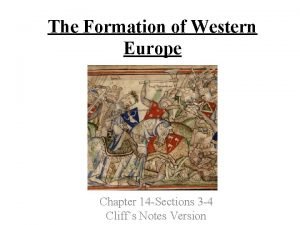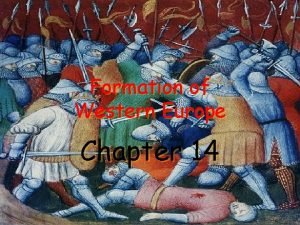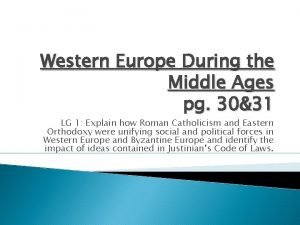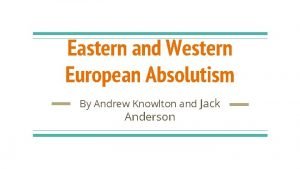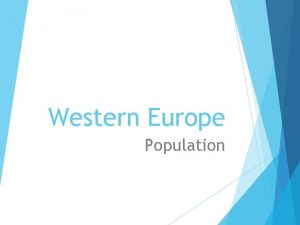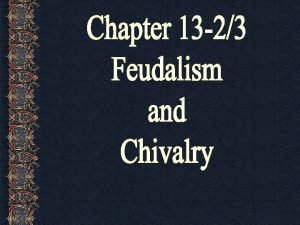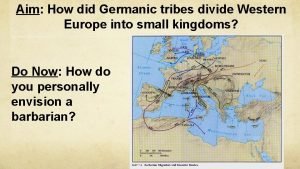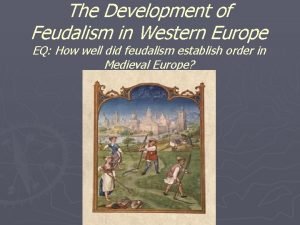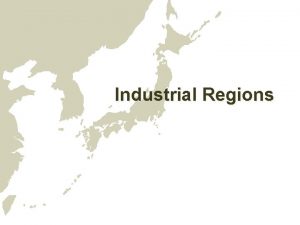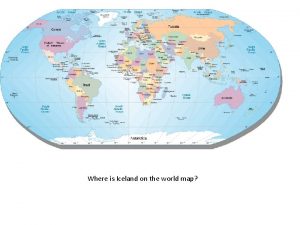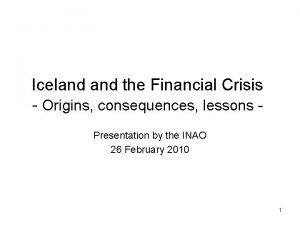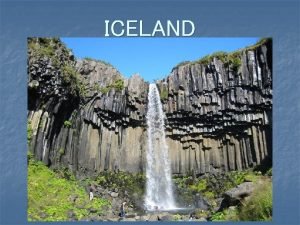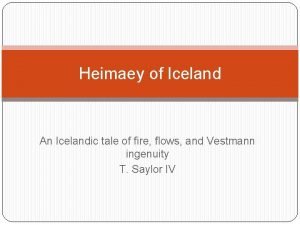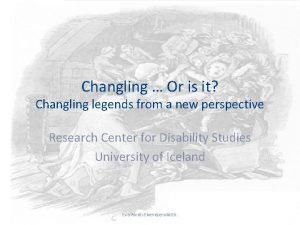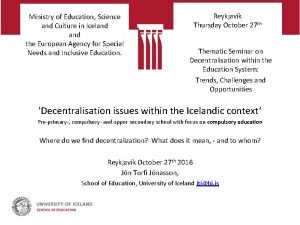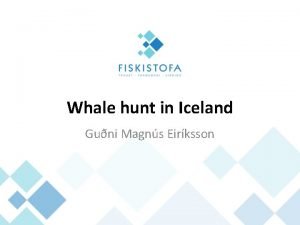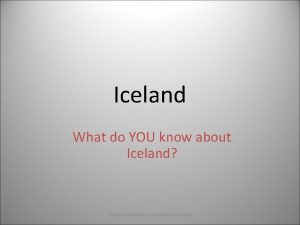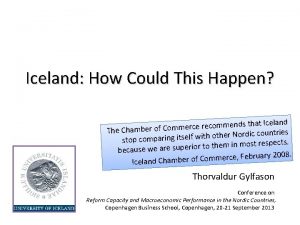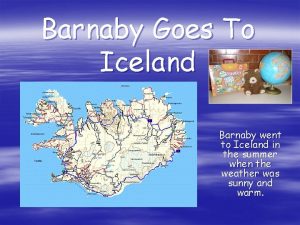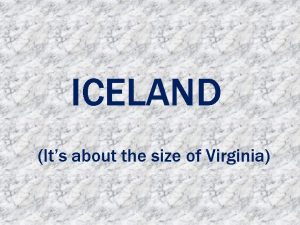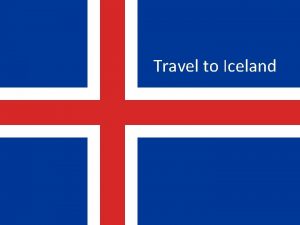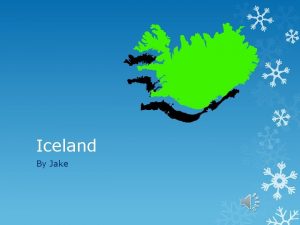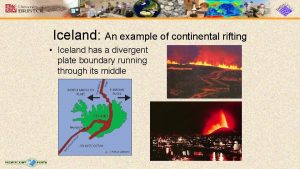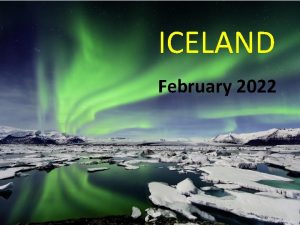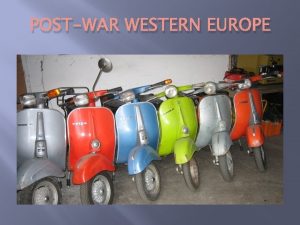Europe Chapter 14 20 I Western Europe Iceland
















- Slides: 16

Europe Chapter 14 -20

I. Western Europe Iceland Norway Sweden Finland Ireland United Kingdom Denmark Netherlands Belgium Germany Luxembourg France Switzerland Austria Italy Spain Portugal Greece

I. Western Europe History A. Cultural diffusion – peoples adopt the practices of their neighbors B. Most of Western Europe was occupied by 35, 000 B. C. This area was once controlled by both the Greek and the Roman empires D. Since then, Western Europe has gone through many different time periods 1. Renaissance – “rebirth” – when westerners began to rediscover the knowledge of the ancient Greeks & Romans 2. Industrial Revolution – “growing use of machines” – spread during the 1800 s with machine power, factories, etc.

E. After 1900, conflicts among the powerful nations in Western Europe caused many wars. 1. World War I: 1914 – 1918 2. World War II: 1939 – 1945 (during which German Nazis killed 6 million Jews & millions more) 3. Cold War: approximately 1947 – 1991 (tense rivalry especially between the USA and Russia) Renaissance Architecture Industrial Revolution Factory

I. Western Europe Characteristics A. Stretches from Scandinavian Peninsula (north) to the Iberian Peninsula (south) B. Nearly every European nation has a coastline, which causes erosion C. North European Plain has many rivers that have long been beneficial for traveling and trading D. The Alps, one of the largest mountain chains in the world, runs through Italy, Austria, Switzerland, Germany, and France (highest peaks are snow-covered all year)

Rhine (Ryn) River that flows through 5 European countries Sea Stacks in Orkney Islands A village in the Alps

I. Western Europe – Climates A. Tropical waters are carried toward Europe and prevailing westerlies (winds that blow across the warm currents) flow in the temperate zones B. Mediterranean Climate – warm summers & cool winters C. Subarctic Climate – mountains along the Scandinavian Peninsula block the winds from the Atlantic creating a very dry, cold, subarctic climate

I. Western Europe Culture A. Western Europe is known for its architecture, art, fashion, and religious institutions B. Many people migrated to this area for employment opportunities C. In the 1950 s, 6 Western European nations formed a “common market” for their economic benefit 1. as it expanded, it became known as the European Union (EU) 2. in 1999, they introduced a single currency – the Euro – that is now used by all member nations

Art Architecture Fashion

II. Central Europe & Northern Eurasia Estonia Latvia Lithuania Poland Belarus Czech Republic Slovakia Ukraine Albania Macedonia Moldova Romania Hungary Slovenia Croatia Bosnia & Herzegovina Serbia & Montenegro Bulgaria Russia

II. Central Europe & Northern Eurasia History A. After the Huns and Avars invaded the area known today as Russia, the Slavs moved into Eastern Europe B. When the Roman Catholic & Eastern Orthodox churches separated in 1054, Eastern European countries became divided between the two religions C. Throughout time, many different empires conquered areas in Eastern Europe 1. Turkish Ottoman Empire conquered southeastern Europe (1500) 2. Austrian Hapsburg emperors gained control of Hungary, Czech lands, and Slovakia by 1526 3. Princes of Moscow became the leaders in Russia by the 1500 s and controlled the largest land area in the world

D. Late 1800 s – Romania, Serbia, and Bulgaria declared independence from Ottomans E. After WWI – Poland, Czechoslovakia, and Hungary gained independence F. Russian Revolution of 1917 led to the creation of the Soviet Union (adopted communism – system where the government controlled almost all aspects of political and economic life) G. After WWII – Soviet Union gained control over most Eastern European countries…kept control until 1989 H. Soviet Union dissolved in 1991 – breaking up into Russia and a number of other smaller nations

II. Central Europe & Northern Eurasia - Characteristics A. This area includes many mountain ranges, plains, and numerous water sources B. Danube River – second-longest river in Europe; starts in Germany and empties into the Black Sea in Bulgaria C. Lake Baikal – Siberia (Russia); world’s deepest lake & largest freshwater lake, holding 20% of world’s fresh water D. Most of the land in Central Europe & Northern Eurasia is covered in plains

II. Central Europe & Northern Eurasia Climate A. There are several different climate regions in this area of the world…it ranges from Mediterranean climate to semi -arid climate to subarctic climate B. Neva River runs through St. Petersburg, Russia – since it is in the subarctic region, it freezes over in the winter and allows its residents to ice fish C. The Black Sea provides warm and humid regions which allows the area to have beach resorts

II. Central Europe & Northern Eurasia Culture A. Since the landscape in this area is generally easy to navigate, migration has made most of the region multiethnic – containing many ethnic groups B. The majority of the people in this area practice the Eastern Orthodox religion – a form of Christianity C. Since there are many ethnic groups (people who share things like culture, language, and religion), there are many different types of music, dance, food, and dress D. Since the 1980 s, many countries in this region have moved from communist lifestyles to democratic thinking

Eastern Orthodox Polish Food Estonian Folk Dance
 Chapter 14 the formation of western europe
Chapter 14 the formation of western europe Chapter 14 the formation of western europe
Chapter 14 the formation of western europe Western uplands europe
Western uplands europe Who was the leader of the franks
Who was the leader of the franks Difference between eastern and western absolutism
Difference between eastern and western absolutism Population of western europe
Population of western europe Invaders attack western europe
Invaders attack western europe How did germanic tribes divide western europe
How did germanic tribes divide western europe The development of feudalism in western europe
The development of feudalism in western europe Western europe hdi
Western europe hdi Iceland in a world map
Iceland in a world map Iceland economic crisis
Iceland economic crisis Iceland: thaw plate -news -china -chinese -alibaba -amazon
Iceland: thaw plate -news -china -chinese -alibaba -amazon Heimaey map
Heimaey map Changeling iceland
Changeling iceland Ministry of education iceland
Ministry of education iceland Eirksson
Eirksson
